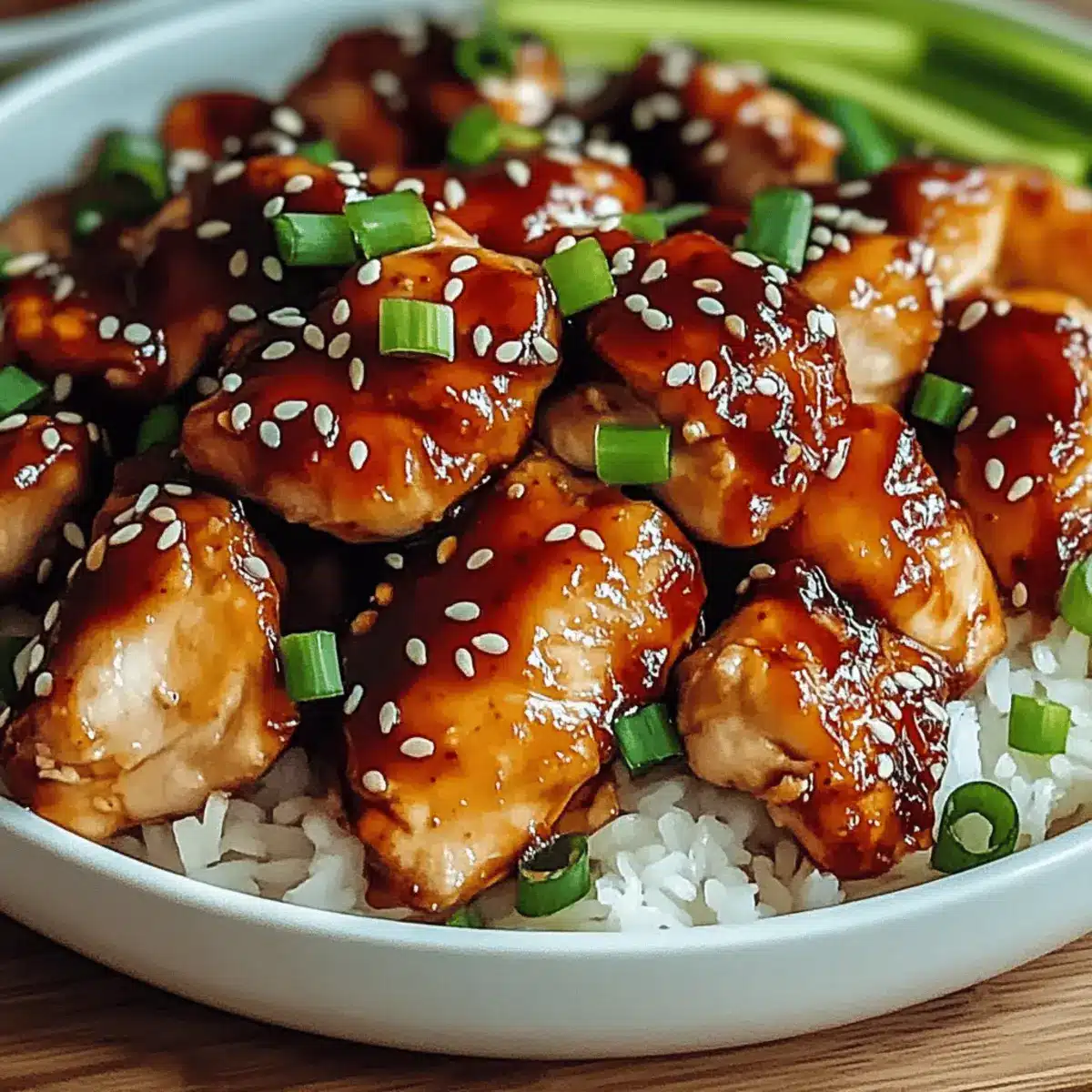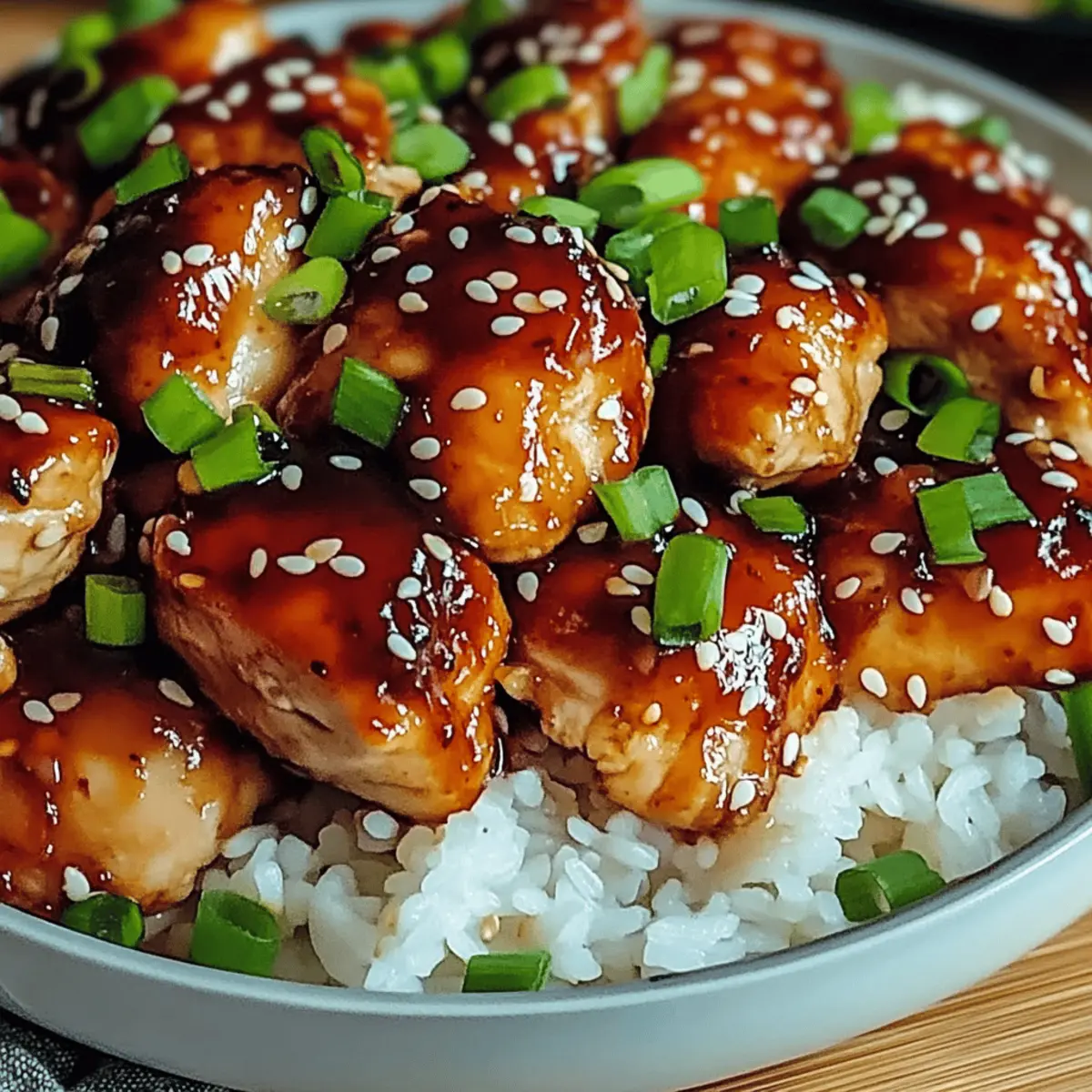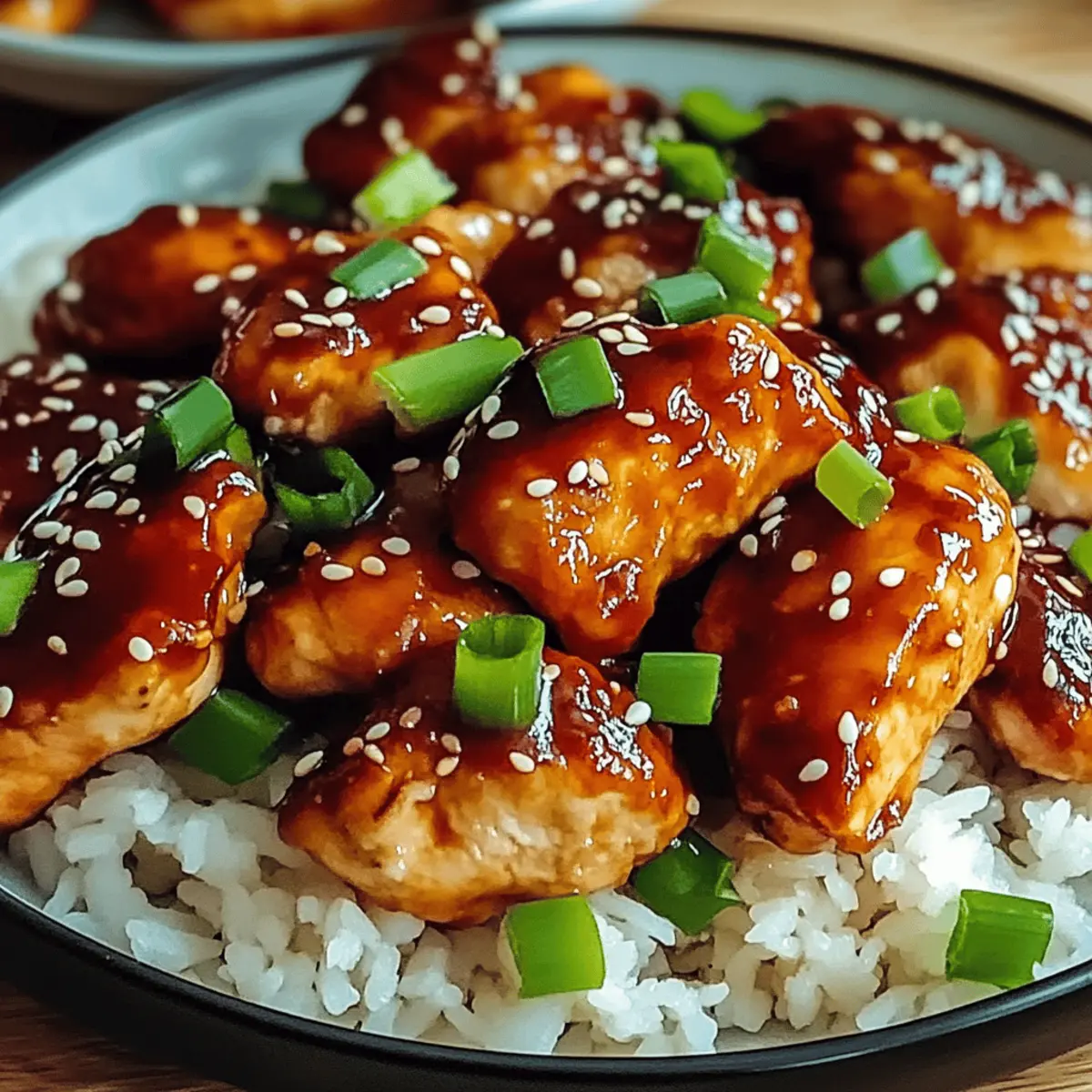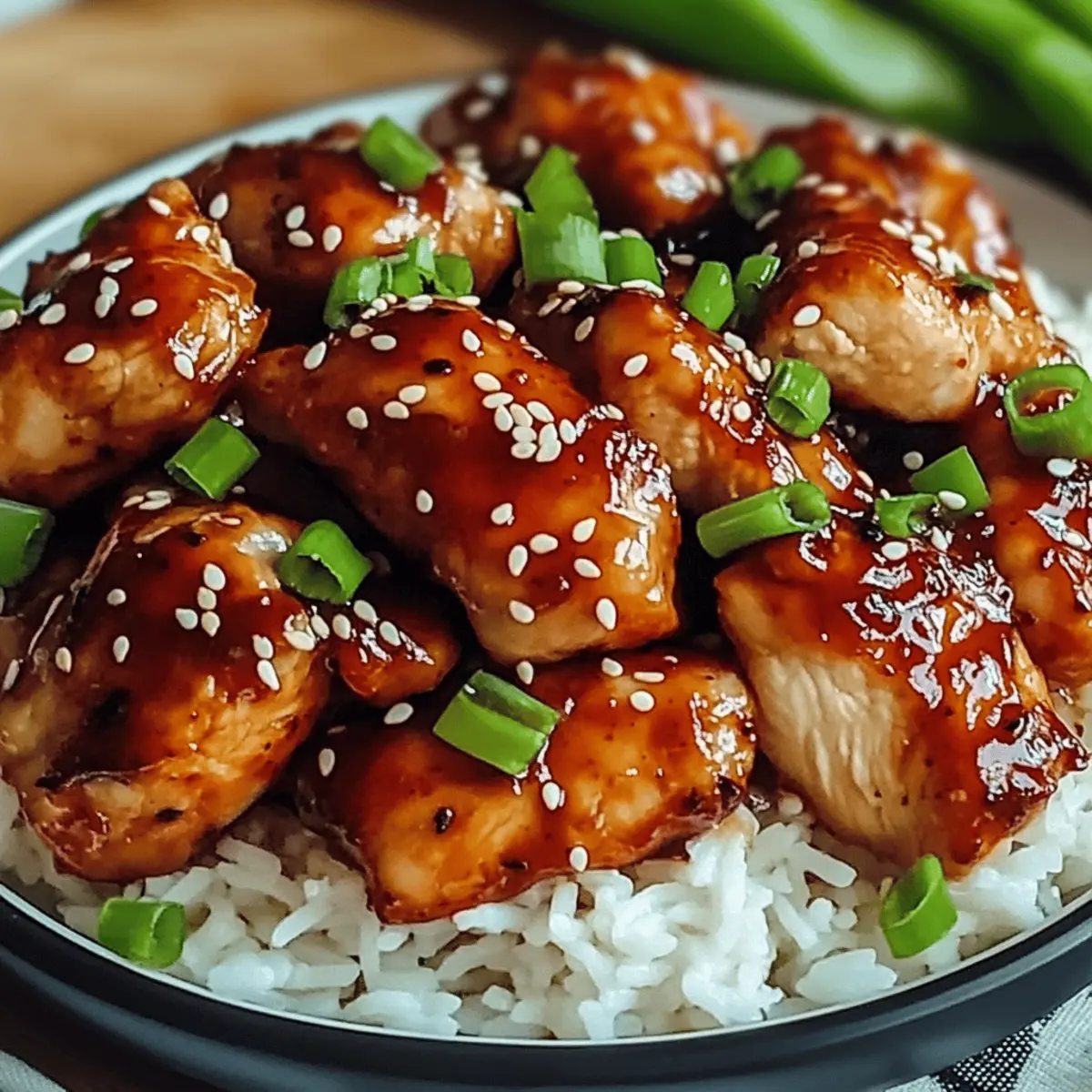As I stood in my kitchen one rainy afternoon, the scent of something special began to fill the air—a warmth that promised comfort and adventure. That’s when I decided to whip up Korean Gochujang Chicken, a dish that beautifully marries the fiery kick of gochujang with a touch of sweetness. Within just 35-40 minutes, I had a vibrant meal ready that not only satisfies the taste buds but also accommodates a variety of heat levels to suit everyone’s palate. This recipe is perfect for busy weeknights yet feels fancy enough to impress guests, making it a true crowd-pleaser. Are you ready to transform your dinner routine with a spicy twist and flavors that will tantalize your senses? Let’s dive into this delicious journey together!

Why is Korean Gochujang Chicken a Must-Try?
Flavor Explosion: The balance of spicy gochujang and sweet honey creates an unforgettable taste sensation. Each bite leaves you craving more!
Quick & Easy: In just 35-40 minutes, you can whip up this gourmet dish, making it perfect for busy weeknights or last-minute dinner parties.
Versatile Adaptations: Customizable to fit any taste preference—try it sweet and sour or a spicy twist with jalapeños!
Nutritious Choice: Packed with protein and colorful veggies, this dish is not just delicious but also a healthy option for you and your family.
Crowd-Pleasing: Serve it over rice or in lettuce wraps to impress your guests—it’s an instant favorite for everyone! For more delightful chicken dishes, check out my Garlic Parmesan Chicken and Chopped Chicken Bacon.
Korean Gochujang Chicken Ingredients
• Get ready for a flavorful experience!
For the Chicken
- Chicken (1 lb / 450g) – Skinless chicken thighs yield juicier results, while breasts are a leaner alternative.
For the Marinade
- Gochujang (2 tablespoons) – This spicy chili paste adds rich umami and heat; adjust for your desired spice level.
- Honey (1 tablespoon) – Balances the heat with sweetness; maple syrup is a great vegan substitute.
- Soy Sauce (2 tablespoons) – Enhances saltiness and umami; opt for low-sodium or tamari for a gluten-free version.
- Sesame Oil (2 teaspoons) – Adds a rich, nutty flavor; olive oil can work as a suitable replacement.
- Garlic (3 cloves, minced) – Fresh garlic boosts aromatics and depth; avoid powdered garlic for the best results.
- Fresh Ginger (1 teaspoon, grated) – Adds warmth; ground ginger can be used, but fresh will elevate the dish.
- Salt & Pepper (to taste) – Adjust these to fit your personal preference.
For Stir-Frying
- Vegetable Oil (1 tablespoon) – Used for sautéing the chicken and vegetables.
- Onion (1/2, sliced) – Adds sweetness and texture; white or yellow onion works best for this dish.
- Bell Pepper (1, sliced) – Offers color and crunch; any variety will add vibrancy to your meal.
For Garnish
- Green Onions – Chopped for freshness and color; chives can be used as a substitute.
- Sesame Seeds – Sprinkle for added crunch and visual appeal.
Now that you have all the essential ingredients for this Korean Gochujang Chicken, you’re well on your way to preparing a mouthwatering dish! Let’s keep cooking!
Step‑by‑Step Instructions for Korean Gochujang Chicken
Step 1: Marinate Chicken
In a mixing bowl, combine 2 tablespoons of gochujang, 1 tablespoon of honey, 2 tablespoons of soy sauce, 2 teaspoons of sesame oil, minced garlic, grated ginger, and a pinch of salt and pepper. Add the chicken pieces to the marinade, ensuring they’re well-coated. Let them marinate for at least 10 minutes, but for deeper flavor, refrigerate for up to 2 hours.
Step 2: Heat Oil
In a large skillet or wok, heat 1 tablespoon of vegetable oil over medium-high heat. Watch as the oil shimmers, signaling it’s ready for cooking. This step is crucial for achieving a nice sear on the chicken, which enhances the overall flavor of your Korean Gochujang Chicken.
Step 3: Sauté Vegetables
Add the sliced onion and bell pepper to the hot skillet. Sauté for about 3-4 minutes, stirring occasionally, until the vegetables are softened and just beginning to caramelize. Once done, remove them from the pan and set aside. This step adds sweetness and texture, creating the perfect base for your chicken.
Step 4: Cook Chicken
In the same skillet, add the marinated chicken along with the leftover marinade. Cook for 5-7 minutes, stirring occasionally, until the chicken is browned and reaches an internal temperature of 165°F (75°C). The chicken should look crispy on the edges, ensuring a delightful texture that pairs beautifully with the sautéed vegetables.
Step 5: Combine
Return the sautéed onion and bell pepper to the skillet with the cooked chicken. Stir everything together, cooking for an additional 2-3 minutes. This melding of flavors will create a luscious sauce that coats the chicken beautifully, making your Korean Gochujang Chicken even more irresistible.
Step 6: Garnish
Once combined, remove the skillet from heat. Generously sprinkle chopped green onions and sesame seeds over the chicken for added color and crunch. This final touch not only enhances the presentation but also adds a fresh note to the dish.
Step 7: Serve
Plate the hot Korean Gochujang Chicken immediately, serving it over a bed of steamed rice or in lettuce wraps for a fun twist. The vibrant colors and enticing aroma will showcase your culinary skills, making it a meal that’s bound to impress your family and guests!

Variations & Substitutions for Korean Gochujang Chicken
Are you ready to take your Korean Gochujang Chicken to new heights? Dive into these delightful variations that will add a personal touch to every bite!
-
Sweet and Sour Style: Add pineapple chunks during cooking for a refreshing and tangy contrast to the spicy sauce. The sweetness from the pineapple balances the heat perfectly.
-
Spicy Twist: Toss in sliced jalapeños for an extra kick. Spice lovers will rejoice as each bite packs an additional punch of flavor.
-
Saucy Version: Double the sauce ingredients for a thicker, glaze-like consistency. This not only elevates the flavor but allows it to cling beautifully to every piece of chicken.
-
Vegetarian Option: Substitute the chicken with tofu or tempeh for a delicious plant-based rendition. Marinating the tofu will help it absorb the robust flavors.
-
Low-Carb Delight: Swap the rice for zucchini noodles or cauliflower rice. This twist maintains the dish’s vibrant flavors while catering to low-carb diets.
-
Herbaceous Boost: Incorporate fresh basil or cilantro for a fragrant twist. These herbs enhance the aromatic profile and add a burst of freshness to your dish.
-
Nutty Flavor: Scatter some chopped peanuts on top for a crunchy texture and added flavor. This provides an exciting contrast to the sauce and juiciness of the chicken.
-
Creamy Twist: For a unique take, stir in a tablespoon of coconut milk towards the end of cooking. This adds creaminess and subtly mellow flavors that complement the spice.
With these variations, you’ll always have a delicious surprise in your meals! For more heavenly chicken ideas, don’t forget to check out my Bbq Chicken Mac or try these stunning Thai Peanut Chicken wraps!
What to Serve with Korean Gochujang Chicken
Elevate your Korean Gochujang Chicken with delicious pairings that enhance its vibrant flavors and create a delightful meal experience.
- Steamed Jasmine Rice: A fluffy bed for the chicken, absorbing the sauce beautifully while providing a subtle fragrance.
- Crispy Asian Slaw: Crunchy veggies tossed in a light sesame dressing add freshness, balancing the dish’s sweet and spicy notes.
- Kimchi: The fermented tang of kimchi introduces a probiotic kick, perfectly complementing the spicy-sweet chicken with its bold flavors.
- Roasted Broccoli: Tender, caramelized florets add a nutty depth, enriching the meal with a nutritious and colorful vegetable.
- Sesame Garlic Noodles: Silky noodles dressed in a savory sauce create a comforting accompaniment, melding flavors without overpowering the main dish.
- Chilled Cucumber Salad: Refreshing and crunchy, this salad cools the palate while enhancing the meal’s overall brightness.
- Mango Chutney: A sweet and spicy chutney can be a unique contrast that complements the boldness of the Korean Gochujang Chicken beautifully.
- Soju Cocktail: This smooth, alcoholic beverage pairs wonderfully with the meal, accentuating the dish’s vibrant flavors with its clean finish.
Expert Tips for Korean Gochujang Chicken
- Perfect Marinade Time: Allow marination for at least 30 minutes or even overnight for deeper flavor; this is key to achieving the best Korean Gochujang Chicken.
- Avoid Overcooking: Cook the chicken just until browned and ensure it reaches an internal temperature of 165°F (75°C) to prevent dryness.
- Customize Spice Level: Adjust the amount of gochujang to fit your heat preference; you can always start with less and add more if desired.
- Fresh Ingredients: Use fresh ginger and garlic for the best aromatic profile; powdered versions can diminish the overall flavor experience.
- Colorful Veggies: Add more vegetables like snap peas or carrots to enhance nutrition and color, making your dish not only tastier but visually appealing.
How to Store and Freeze Korean Gochujang Chicken
-
Fridge: Store leftovers in an airtight container for up to 3-4 days. This will keep the flavors intact while making reheating a breeze.
-
Freezer: For longer storage, freeze the Korean Gochujang Chicken in a freezer-safe container for up to 2 months. Ensure it’s well-wrapped to prevent freezer burn.
-
Reheating: When ready to enjoy your leftovers, reheat on the stovetop with a splash of water over medium heat. This keeps the chicken moist and flavorful.
-
Thawing: If frozen, thaw in the fridge overnight before reheating. This ensures even heating and preserves the delicious flavors of your dish.
Make Ahead Options
These Korean Gochujang Chicken are perfect for meal prep enthusiasts! You can marinate the chicken pieces in the flavor-packed mixture of gochujang, honey, and soy sauce up to 24 hours in advance, ensuring maximum flavor infusion. To further streamline your cooking, slice the onion and bell pepper and store them in an airtight container in the refrigerator for up to 3 days. When you’re ready to cook, simply heat the oil, sauté the prepped vegetables for a few minutes, then add the marinated chicken and continue with the recipe as directed. This way, you’ll enjoy restaurant-quality results on busy weeknights with minimal effort, making dinnertime a breeze!

Korean Gochujang Chicken Recipe FAQs
What kind of chicken should I use for Korean Gochujang Chicken?
Absolutely! For the best results, I recommend using skinless chicken thighs as they tend to be juicier and more flavorful. However, chicken breasts can be used for a leaner option. Just remember to adjust your cooking time slightly, as breasts may cook faster.
How long can I store Korean Gochujang Chicken in the fridge?
You can store leftovers in an airtight container in the fridge for up to 3-4 days. Just make sure to keep it sealed to maintain that delicious flavor while it’s waiting to be enjoyed again.
Can I freeze Korean Gochujang Chicken? If so, how?
Yes, you can freeze Korean Gochujang Chicken! Place it in a freezer-safe container after cooking, ensuring it’s tightly sealed to prevent freezer burn. It will stay fresh for up to 2 months. When you’re ready to enjoy it, thaw it overnight in the fridge before reheating.
What do I do if my chicken ends up too dry?
If you find yourself with dry chicken, reheat it gently with a splash of water or chicken broth in a skillet, covered. This will help steam the chicken and add moisture back into each bite. Also, be careful to monitor cooking time; an internal temperature of 165°F (75°C) is ideal to avoid dryness.
Are there any dietary considerations for Korean Gochujang Chicken?
Very! This dish can easily be made gluten-free by using tamari instead of traditional soy sauce. For those watching their sugar intake, consider substituting honey with a sugar-free sweetener. Plus, if you’re concerned about spice levels, adjust the amount of gochujang to suit everyone’s palate!

Korean Gochujang Chicken: Spicy-Sweet Bliss in Every Bite
Ingredients
Equipment
Method
- In a mixing bowl, combine gochujang, honey, soy sauce, sesame oil, minced garlic, grated ginger, and salt and pepper. Add chicken and marinate for at least 10 minutes, up to 2 hours.
- In a large skillet or wok, heat vegetable oil over medium-high heat.
- Add sliced onion and bell pepper to the skillet and sauté for about 3-4 minutes.
- In the same skillet, add marinated chicken and the leftover marinade. Cook for 5-7 minutes until chicken is browned and reaches an internal temperature of 165°F.
- Return the sautéed onion and bell pepper to the skillet with the cooked chicken and stir together for an additional 2-3 minutes.
- Remove from heat and sprinkle with chopped green onions and sesame seeds.
- Serve immediately over rice or in lettuce wraps.

Leave a Reply